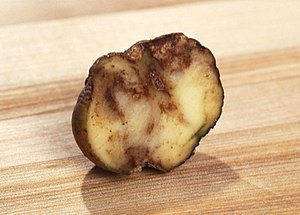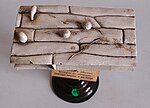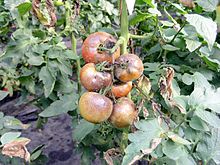Phytophthora infestans
| Phytophthora infestans | ||||||||||||
|---|---|---|---|---|---|---|---|---|---|---|---|---|

Section through a potato infested with tuber rot |
||||||||||||
| Systematics | ||||||||||||
|
||||||||||||
| Scientific name | ||||||||||||
| Phytophthora infestans | ||||||||||||
| ( Mont. ) De Bary |
Phytophthora infestans ( late blight, potato powdery mildew ) is a type of egg fungus . This pathogen infects a number of Solanaceae and isolated representatives of the families of the daisy family , bindweed and nyctaginaceae . Economically important host species of Phytophthora infestans are potatoes , tomatoes and petunias ; an infestation of aubergines and peppers is very rare.
The parasite came to Flanders from North America, where it first appeared in 1843, with infected potatoes in the winter of 1843/44 . Here he went unnoticed in 1845.
The potato infestation caused famine in Ireland from 1845 to 1849 and elsewhere in Europe, for example in Luxembourg .
Symptoms and Biology
The disease caused by the pathogen is in the tomato late blight in the potato late blight . The infestation of potatoes, especially in damp summers, sometimes also in spring, when the pathogen finds optimal conditions for propagation, leads to yield losses that can regularly exceed 20% of the average yield. In the case of tomatoes in the field, the disease caused by Phytophthora infestans can lead to the total loss of the harvest.
The first symptoms of the disease are visible on the leaves and stems: dark brown spots appear from the leaf edges. They enlarge quickly in damp weather or when there is heavy dew formation and form a white fungal lawn on the underside of the leaves, reminiscent of mold . Spore containers ( sporangia ) develop at the ends of the fungal threads . The spores are released when wet and actively penetrate the plant tissue with the help of a germ tube. At temperatures above 10 ° C, the sporangia also germinate directly. The fungus gets into the tubers via wounds, natural intercellular openings ( lenticels ) and germination systems during the growing season or during harvest. Affected tubers have gray-blue discolored spots and brown tuber meat - without any sharp demarcation from healthy tissue. They are inedible. The fungus overwinters in the tubers. A single infected tuber can be enough to trigger an epidemic in a potato crop.
The genome of Phytophthora infestans was completely sequenced in 2009.
Development cycle
The diploid oospore first germinates with a sporangium, which forms the flagellated planospores. These spores penetrate the host plant through stomata and form a mycelium there, from which sporangia carriers arise again. However, this only happens in suitable, damp weather conditions. The sporangia carriers protruding from the stomata again release sporangia.
During the sexual reproduction of this heterothallic species, oogametangiogamy occurs: the oogonium grows through the antheridium of the other type of cross. Then meiosis occurs in the cells that have not yet fused. Three of the four cells created in this way degenerate and now the compartments of the gametangia and their nuclei fuse. This is how the oospore is created.
Combat
Late blight in potatoes
The late blight of the potato can be combated with various fungicides. Means with systemic, partial systemic, translaminar and contact-active modes of action are available for this purpose. They have to be applied several times before harvest. In the main growth of the herb, mostly systemic, then later in the culture subsystemic and finally contact-active agents are applied. There are forecast models (such as SIMPHYT, PhytophthoraModell Weihenstephan, ProPlant expert, PrognoOnline Potato, PhytoPre) to predict the optimal control dates. During treatment, it must be noted that Phytophthora is resistant to active ingredients from the active ingredient groups phenylamides (such as: Benalaxyl , Metalaxyl –M, Ofurac , Oxadixyl ) and carbamates ( propamocarb ) as well as the active ingredient dimethomorph . In general, resistance can be expected sooner or later if the same active ingredient is always used. To prevent the formation of resistance, it is advisable to change the active ingredient between the treatments and active ingredient groups or to apply active ingredients with different effects at the same time (systemic / subsystemic mixed with contact active). To prevent the pathogen from spreading from the infested potato tops to the tubers, the herb is killed with caustic herbicides or by shelling about three weeks before harvest . In addition to chemical control strategies, the loss of yield can also be reduced by choosing resistant varieties and pre-germinating the seed potatoes. When choosing a variety, it should be noted that the leaf resistance of potatoes differs from the tuber resistance. The resistant varieties include the South American species Solanum bulbocastanum , which was used by the BASF Group as the basis for the genetically modified Fortuna variety .
Late blight and brown rot in tomatoes
Phytophthora can be effectively prevented by roofing the plants against rain and avoiding wet leaves when watering. The reason for this is that the pathogen needs liquid water to germinate. As with potatoes, there are also varieties of tomatoes that are less susceptible, but these are often more small-fruited. In addition, tomatoes should not be in close proximity to potatoes. The pathogen first grows on potatoes, forms spores and is then transmitted to tomatoes by the wind.
history
A variant of the pathogen called HERB-1 was introduced into Europe from North America around 1840 and caused major crop failures from 1845 to 1849. The worst hit was Ireland, where the Great Famine struck. But in other parts of Europe, too, there were bad harvests, which particularly affected the poorer classes for whom the potato had become a staple food (see the potato revolution in Berlin 1847). In the more than 50 years of its activity, however, according to an investigation by the Max Planck Institute for Developmental Biology, the pathogen did not develop significantly further genetically and finally disappeared after the introduction of resistant potato varieties. Instead, a new strain of pathogen called US-1 spread at the beginning of the 20th century, which is related to HERB-1, but whose common line of development separated shortly before the outbreak of HERB-1 in Europe.
In the early 1980s, a new type of population was introduced to Europe from the Phytophthora infestans gene center in Mexico . This population is capable of sexual reproduction with the P. infestans strains that are already present in Europe . Therefore, the pathogens can change faster than before. The plants need a certain amount of time to develop resistance; until then you have nothing to oppose the pathogen.
literature
- Bärbel Schöber-Butin: The late blight of the potato and its causal agent Phytophthora infestans (MONT.) DE BARY. In: Messages from the Federal Biological Research Center for Agriculture and Forestry Berlin-Dahlem. Issue 384, Federal Biological Research Center for Agriculture and Forestry, Berlin and Braunschweig 2001, ISBN 3-8263-3360-8 (PDF; 2 MB)
- George N. Agrios: Plant Pathology. Academic Press, 2005; ISBN 0-12-044565-4
Web links
- Purple potato is immune to potato powdery mildew. From: Wissenschaft.de from September 20, 2001, accessed on September 9, 2019
- Leaf rot and tuber rot monitoring in potatoes. Warning service of the Austrian Chamber of Agriculture, accessed on September 9, 2019
Individual evidence
- ↑ Spectrum Lexicon of Biology: Late Blight and Tuber Blight , accessed on October 19, 2017.
- ↑ a b c Spectrum Lexicon of Biology: False powdery mildew mushrooms , accessed on November 12, 2015.
- ↑ Jos. A. Massard (2009): 300 years of potatoes in Luxembourg . ( PDF, p. 17 and footnote 181 )
- ^ Brian J. Haas et al .: Genome sequence and analysis of the Irish potato famine pathogen Phytophthora infestans . In: Nature . tape 461 , no. 7262 , September 17, 2009, p. 393–398 , doi : 10.1038 / nature08358 .
- ^ P. Rouselle, Y. Robert and JC Crosnier et al .: La pomme de terre - production, amélioration, ennemies et maladies, utilizations , INRA, Paris 1996, pp. 283–291, ISBN 2-7380-0676-0 , ISSN 1144-7605
- ↑ Marc Strehler: Does gene tuber bring Fortuna luck? , pfaelzischer-merkur.de, August 18, 2009, accessed on November 17, 2012.
- ^ Convicted after 160 years - Herbaria reveal the genome of the Irish Famine . In: press release . Senckenberg Society for Nature Research . May 21, 2013. Retrieved October 21, 2013.
- ↑ K. Yoshida, L. Cano, M. Pais, B. Mishra, R. Sharma, C. Lanz, F. Martin, S. Kamoun, J. Krause, M. Thines, D. Weigel & H. Burbano: The rise and fall of the Phytophthora infestans lineage that triggered the Irish potato famine. In: eLife , May 28, 2013, doi: 10.7554 / elife.00731 .




